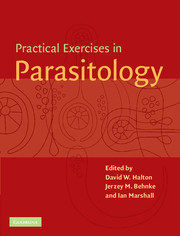Book contents
- Frontmatter
- Contents
- List of contributors
- Preface
- General advice
- 1 Observational Exercises on Parasites
- 2 Ecology
- 2.1 Pin worms (Nematoda, Oxyuroidea) in the American cockroach, Periplaneta americana
- 2.2 Distribution and microhabitat of a monogenean on the gills of mackerel
- 2.3 Population dynamics of Gyrodactylus on stickleback
- 2.4 Intraspecific competition in the cestode Hymenolepis diminuta, in rats
- 2.5 Transmission dynamics and the pattern of dispersion of the cestode Hymenolepis diminuta, in the intermediate host population
- 3 Physiology and Biochemistry
- 4 Pathology and Immunology
- 5 Chemotherapy
- 6 Molecular Parasitology
- 7 Behaviour
- Appendix 1 Reagent index
- Appendix 2 UK suppliers
- Appendix 3 US suppliers
- Index
2.4 - Intraspecific competition in the cestode Hymenolepis diminuta, in rats
Published online by Cambridge University Press: 05 June 2012
- Frontmatter
- Contents
- List of contributors
- Preface
- General advice
- 1 Observational Exercises on Parasites
- 2 Ecology
- 2.1 Pin worms (Nematoda, Oxyuroidea) in the American cockroach, Periplaneta americana
- 2.2 Distribution and microhabitat of a monogenean on the gills of mackerel
- 2.3 Population dynamics of Gyrodactylus on stickleback
- 2.4 Intraspecific competition in the cestode Hymenolepis diminuta, in rats
- 2.5 Transmission dynamics and the pattern of dispersion of the cestode Hymenolepis diminuta, in the intermediate host population
- 3 Physiology and Biochemistry
- 4 Pathology and Immunology
- 5 Chemotherapy
- 6 Molecular Parasitology
- 7 Behaviour
- Appendix 1 Reagent index
- Appendix 2 UK suppliers
- Appendix 3 US suppliers
- Index
Summary
Aims and objectives
This exercise is designed to demonstrate:
The effect of parasite population density on adult cestode size.
The effect of parasite population density on parasite fecundity.
The relationship between parasite size and fecundity.
Introduction
It has been known for a long time that there is a relationship between the number of parasites of a species in a host (infra-population density) and parasite size and fecundity. The relationship originally referred to as a crowding effect is most easily observed in parasites such as cestodes, in which growth is relatively indeterminate and adult size maybe large. This effect can be detected in other groups of parasites such as nematodes and acanthocephalans, but these are often smaller in size and growth is more determinate.
The crowding effect has been studied most intensively in cestodes, and whilst there is a measure of agreement on its manifestation, and its population consequences, there is less agreement on its causation. One school of thought believes it is an example of intra-specific competition, probably for carbohydrate resources, which become increasingly scarce as infra-population density increases. Another school believes that it is a result of a host immune response, which increases in intensity and effectiveness as infra-population density increases. A third school believes that it is caused by secretions from the parasites that suppress growth. Whatever the cause, there is no doubt that it is potentially a very effective regulator and stabiliser of parasite population density, since the effect on fecundity is density-dependent.
- Type
- Chapter
- Information
- Practical Exercises in Parasitology , pp. 161 - 166Publisher: Cambridge University PressPrint publication year: 2001
- 1
- Cited by



